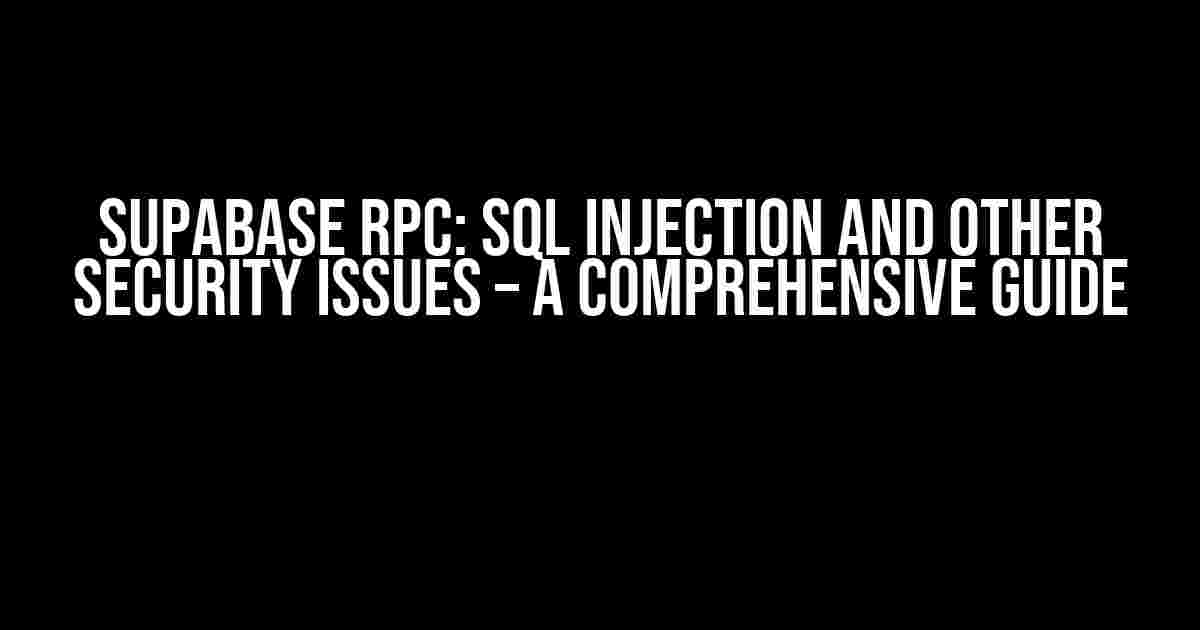Supabase RPC (Remote Procedure Call) is a powerful tool that allows developers to interact with their databases in a more efficient and scalable way. However, with great power comes great responsibility, and it’s essential to address the potential security issues that come with using Supabase RPC. In this article, we’ll delve into the world of SQL injection and other security concerns, providing you with clear instructions and explanations to help you protect your Supabase RPC applications.
What is SQL Injection?
SQL injection is a type of web application security vulnerability that allows an attacker to inject malicious SQL code into your database. This can lead to unauthorized access, data theft, or even complete system compromise. In the context of Supabase RPC, SQL injection can occur when user input is not properly sanitized or validated, allowing an attacker to inject malicious SQL queries.
Types of SQL Injection
There are several types of SQL injection attacks, including:
- Classic SQL Injection: This type of attack involves injecting malicious SQL code into a web application to extract or modify sensitive data.
- Blind SQL Injection: This type of attack involves injecting malicious SQL code to extract data without directly accessing the database.
- Time-Based SQL Injection: This type of attack involves injecting malicious SQL code to extract data by manipulating the timing of the database responses.
How to Prevent SQL Injection in Supabase RPC
To prevent SQL injection in Supabase RPC, follow these best practices:
- Use Prepared Statements: Prepared statements separate the SQL code from the user input, making it difficult for an attacker to inject malicious code.
- Validate User Input: Always validate and sanitize user input to prevent malicious data from entering your database.
- Limit Database Privileges: Limit the privileges of the database user to prevent an attacker from accessing sensitive data or modifying the database structure.
- Regularly Update and Patch: Regularly update and patch your Supabase RPC application and dependencies to prevent exploitation of known vulnerabilities.
Example of Prepared Statement in Supabase RPC
import { supabase } from '../supabase';
const { data, error } = await supabase
.from('users')
.select('name, email')
.where('name', 'starts_with', 'John')
.prepare();
In this example, we use a prepared statement to select data from the “users” table where the “name” column starts with “John”. The prepared statement separates the SQL code from the user input, making it secure against SQL injection attacks.
Other Security Issues in Supabase RPC
While SQL injection is a significant security concern, it’s not the only issue to worry about when using Supabase RPC. Here are some other security issues to be aware of:
Insecure Direct Object Reference (IDOR)
IDOR occurs when an application exposes a reference to an internal object, allowing an attacker to access or modify sensitive data. In Supabase RPC, this can happen when using insecure object references in queries.
Cross-Site Request Forgery (CSRF)
CSRF occurs when an attacker tricks a user into performing an unintended action on a web application. In Supabase RPC, this can happen when using insecure authentication mechanisms or failing to validate user input.
Insecure Data Storage
Insecure data storage occurs when sensitive data is stored in plain text or without proper encryption. In Supabase RPC, this can happen when storing sensitive data in the database without proper encryption or access controls.
Best Practices for Secure Supabase RPC Development
To ensure secure Supabase RPC development, follow these best practices:
- Use Secure Authentication: Implement secure authentication mechanisms, such as OAuth or JWT, to validate user identities and authorize access to the database.
- Use Encryption: Use encryption to protect sensitive data both in transit and at rest.
- Validate User Input: Always validate and sanitize user input to prevent malicious data from entering your database.
- Use Least Privilege Principle: Limit the privileges of the database user to prevent an attacker from accessing sensitive data or modifying the database structure.
- Regularly Monitor and Audit: Regularly monitor and audit your Supabase RPC application to detect and respond to security incidents.
Conclusion
Supabase RPC is a powerful tool that can revolutionize the way you interact with your database. However, it’s essential to address the potential security issues that come with using Supabase RPC. By following the best practices outlined in this article, you can ensure the security and integrity of your Supabase RPC applications.
Supabase RPC Security Checklist
Use this checklist to ensure the security of your Supabase RPC applications:
| Security Issue | Prevention Mechanism |
|---|---|
| SQL Injection | Use Prepared Statements, Validate User Input, Limit Database Privileges |
| IDOR | Use Secure Object References, Limit Database Privileges |
| CSRF | Use Secure Authentication, Validate User Input |
| Insecure Data Storage | Use Encryption, Limit Database Privileges |
By following this checklist, you can ensure the security and integrity of your Supabase RPC applications and protect your data from potential threats.
Final Thoughts
Supabase RPC is a powerful tool that requires careful consideration of security issues. By understanding the potential security concerns and following best practices, you can ensure the security and integrity of your Supabase RPC applications. Remember, security is an ongoing process, and regular monitoring and auditing are essential to detecting and responding to security incidents. With the right knowledge and practices, you can harness the power of Supabase RPC while keeping your data safe and secure.
Frequently Asked Question
Get the answers to your burning questions about Supabase RPC: SQL Injection and other security issues!
What is SQL Injection and how does it affect Supabase RPC?
SQL Injection is a type of web application security vulnerability that allows an attacker to inject malicious SQL code to access, modify, or manipulate sensitive data. In the context of Supabase RPC, SQL Injection can occur when user input is not properly sanitized, allowing an attacker to inject malicious SQL code that can compromise the security of your database. To mitigate this risk, it’s essential to use parameterized queries and input validation to ensure that only authorized data is accessed and modified.
How can I prevent SQL Injection in my Supabase RPC application?
To prevent SQL Injection in your Supabase RPC application, follow these best practices: use parameterized queries, validate user input, limit database privileges, keep your database software and dependencies up-to-date, and implement input sanitization and escaping. Additionally, consider using a Web Application Firewall (WAF) to detect and prevent SQL Injection attacks.
What are some common security issues with Supabase RPC besides SQL Injection?
Besides SQL Injection, other common security issues with Supabase RPC include cross-site scripting (XSS), cross-site request forgery (CSRF), authentication and authorization bypass, and data encryption vulnerabilities. Additionally, issues like insecure file uploads, CORS misconfigurations, and vulnerable dependencies can also compromise the security of your Supabase RPC application.
How can I detect and respond to SQL Injection attacks on my Supabase RPC application?
To detect and respond to SQL Injection attacks on your Supabase RPC application, implement a monitoring system to track database activity, set up alerts for suspicious queries, and regularly review logs for signs of unauthorized access. In the event of an attack, respond quickly by isolating the affected database, identifying the vulnerability, and patching the exploit. Finally, conduct a thorough incident response and consider engaging a security expert to help contain and remediate the incident.
Are there any tools or resources available to help secure my Supabase RPC application?
Yes, there are several tools and resources available to help secure your Supabase RPC application. Consider using SQL vulnerability scanners, web application scanners, and static analysis tools to identify vulnerabilities. Additionally, leverage resources like the OWASP Security Cheat Sheet, the Supabase RPC documentation, and online communities like GitHub and Reddit to stay informed about the latest security best practices and threats.


